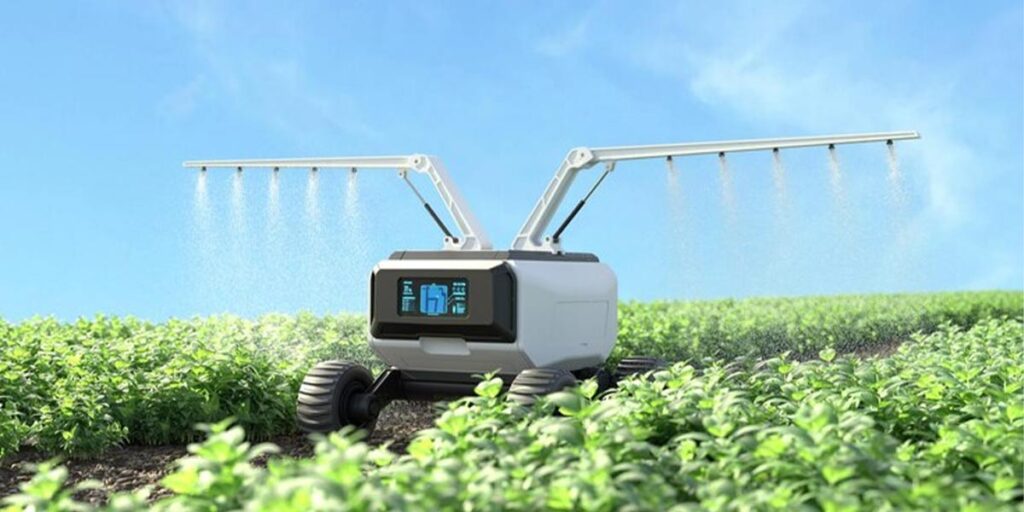Imagine a world where tedious and labor-intensive spraying tasks are performed flawlessly by machines. Robotic spraying machine are making this a reality, bringing precision, efficiency, and sustainability to industries like agriculture and manufacturing. These advanced machines are changing how we approach spraying tasks, offering solutions that reduce human effort while maximizing output.
In this article, we’ll delve into the evolution, functionality, and impact of robotic spraying machines. Whether you’re a farmer aiming to boost yields or a manufacturer seeking uniform coatings, these robots are shaping the future of spraying operations.

Evolution of Robotic Spraying Technology
Robotic spraying machines have come a long way. Traditional spraying methods, relying on manual labor and rudimentary equipment, often led to uneven applications and wasted resources. Enter robotics, and the game changed.

Modern robotic systems incorporate AI, sensors, and precision tools to revolutionize spraying. Milestones like the integration of GPS-guided drones and real-time monitoring systems have further elevated the efficiency of these machines. By marrying technology with practical spraying needs, robotic systems are transforming industries globally.
Components of a Robotic Spraying Machine
To understand how these machines work, let’s break down their components:
Hardware Components
Robotic spraying machines rely on high-quality hardware for optimal performance. This includes:
- Spraying Arms and Nozzles: Designed for consistent spray patterns.
- Sensors and Cameras: Detect target areas and measure distances.
- Motors and Drives: Enable movement and operation across terrains.
Software Components
Advanced control systems and mapping algorithms ensure these machines perform with precision. The software integrates real-time data from sensors to make dynamic adjustments, guaranteeing accuracy and minimizing waste.
Components of a Robotic Spraying Machine

To understand how these machines work, let’s break down their components:
Hardware Components
Robotic spraying machines rely on high-quality hardware for optimal performance. This includes:
- Spraying Arms and Nozzles: Designed for consistent spray patterns.
- Sensors and Cameras: Detect target areas and measure distances.
- Motors and Drives: Enable movement and operation across terrains.
Software Components
Advanced control systems and mapping algorithms ensure these machines perform with precision. The software integrates real-time data from sensors to make dynamic adjustments, guaranteeing accuracy and minimizing waste.
Types of Robotic Spraying Machine
Agricultural Robots
These robots are a game-changer for farming. Specialized machines can spray crops and orchards, targeting pests and weeds with unmatched precision. Drones equipped with spraying systems are particularly popular for large fields, offering speed and thorough coverage.
Industrial Sprayers
In industries like automotive manufacturing, robotic sprayers handle painting and coating tasks with finesse. They provide uniform layers, essential for quality finishes, and are also used for cleaning and sanitizing applications.
How Robotic Spraying Machines Work
The magic lies in their integration of sensors and automation. Sensors detect areas requiring spraying, while cameras provide detailed visual data. These inputs feed into navigation systems that guide the robot along efficient paths, avoiding obstacles and ensuring comprehensive coverage. This combination of precision and autonomy sets robotic spraying machines apart from traditional methods.
Benefits of Robotic Spraying Machine
Improved Efficiency
Robots don’t tire or make errors, making them ideal for repetitive tasks. They work faster and maintain consistent spray patterns, ensuring every inch of the target area is covered.
Cost Savings
While the initial investment might be high, robotic spraying machines save money in the long run by reducing labor costs and minimizing waste of resources like chemicals and water.
Environmental Benefits
Sustainability is another win. These machines apply chemicals only where needed, reducing runoff and promoting eco-friendly practices.
Benefits of Robotic Spraying Machine
Enhanced Safety
Robotic sprayers significantly reduce human exposure to hazardous chemicals. In agriculture, for instance, operators no longer need to come into direct contact with pesticides or herbicides, minimizing health risks. Similarly, in industrial applications, workers avoid inhaling toxic fumes during painting or coating processes.
Precision Application
One of the standout advantages of robotic spraying machines is their accuracy. They’re equipped to measure and dispense the exact amount of liquid required, targeting specific areas while avoiding overlap. This level of precision not only improves efficiency but also enhances the quality of the outcome.
Challenges in Adopting Robotic Spraying Machine
As transformative as they are, robotic spraying machines come with their own set of challenges.
High Initial Costs
The price tag of robotic sprayers can be a deterrent, especially for small-scale farmers or businesses. The investment often includes not just the machine but also the software, training, and installation.
Training Requirements
Unlike traditional methods, robotic systems require operators to have a basic understanding of technology. Training is necessary to ensure smooth operation, which can add to the adoption costs and time.
Maintenance and Technical Challenges
These machines rely on intricate hardware and software systems that demand regular maintenance. Any failure in sensors, motors, or software can result in downtime, impacting productivity. Ensuring reliable after-sales support is crucial to overcoming these hurdles.
Industries Benefiting from Robotic Spraying Machine
Agriculture
Robotic spraying machines have become indispensable in modern farming. From precision pesticide application to fertilizing crops, they allow farmers to cover large areas efficiently. These machines are also effective in targeting specific plants or pests, which is especially beneficial in orchards and vineyards.
Manufacturing
Industries like automotive and aerospace use robotic sprayers for painting, coating, and finishing tasks. These machines ensure uniform layers and minimize material wastage. They’re also used in cleaning and sanitizing large industrial spaces.
Healthcare and Sanitation
The pandemic highlighted the importance of automated spraying systems in sanitizing public spaces. Robotic sprayers are now widely used for disinfecting hospitals, airports, and other high-traffic areas.
Future Trends in Robotic Spraying

The future of robotic spraying machines is bright, with several trends pointing toward even greater efficiency and innovation.
AI-Driven Decision-Making
With advancements in artificial intelligence, future robotic sprayers will analyze environmental factors like wind speed, humidity, and terrain to optimize spraying operations.
Energy Efficiency
Newer models are focusing on energy-efficient systems, using renewable energy sources like solar panels to power operations. This makes robotic sprayers not only smarter but also more sustainable.
Multi-Functional Robotic Spraying Machine
Imagine a single machine capable of performing multiple tasks: spraying, weeding, and even planting. Developers are working on robots that integrate various agricultural functions, reducing the need for multiple machines.
Case Studies: Successful Implementation
Case Study 1: Smart Farms in California
A large-scale vineyard in California adopted drone-based robotic sprayers, reducing pesticide use by 30% while achieving better pest control. The drones’ precision and speed allowed the farm to cover its expansive fields in record time.
Case Study 2: Automotive Painting in Germany
A leading car manufacturer introduced robotic painting systems that reduced material wastage by 20% and enhanced finish quality. The robots operated 24/7, significantly increasing production output.
Case Study 3: Disinfection Robots in Singapore
During the COVID-19 pandemic, Singapore deployed robotic sprayers to sanitize public spaces. These machines covered large areas efficiently and reduced the risk of infection for frontline workers.
How to Choose the Right Robotic Spraying Machine
Selecting the right robotic sprayer depends on your specific needs. Here’s a guide to help you make an informed decision:
Assess Your Needs
Determine the scale and type of spraying tasks you require. For agricultural purposes, consider the size of your fields and the type of crops. For industrial applications, evaluate the complexity of the spraying process.
Evaluate Features
Look for machines with advanced features like GPS navigation, real-time monitoring, and adjustable spray patterns. Ensure the robot is compatible with the materials you’ll be using, whether pesticides, paints, or disinfectants.
Consider Costs and ROI
While initial costs are high, focus on the long-term savings. Analyze the machine’s efficiency in reducing labor, material, and operational expenses to calculate the return on investment.
Maintenance and Care for Robotic Sprayers
Keeping your robotic spraying machine in top condition ensures its longevity and optimal performance. Follow these steps for effective maintenance:
Regular Cleaning
After each use, clean the nozzles and spraying arms to prevent clogs. Chemical residues can corrode parts over time, so thorough cleaning is essential.
Software Updates
Manufacturers often release software updates to improve functionality and address bugs. Regularly update the machine’s software to keep it running smoothly.
Routine Inspections
Schedule regular inspections to check for wear and tear on components like motors, sensors, and drives. Addressing small issues early can prevent costly repairs later.
Long-Term Care
Invest in a maintenance plan offered by the manufacturer. This often includes expert servicing, ensuring your robot operates at peak efficiency for years.
Comparing Leading Brands in Robotic Spraying
Here’s a comparison of top robotic spraying machine manufacturers:
| Brand | Key Features | Applications | Price Range |
|---|---|---|---|
| AgriBot | AI-driven crop sprayers | Agriculture | $15,000 – $30,000 |
| SprayTech | Industrial-grade precision sprayers | Manufacturing, Healthcare | $25,000 – $50,000 |
| DroneSpray | GPS-enabled spraying drones | Large-scale agriculture | $10,000 – $20,000 |
FAQs About Robotic Spraying Machine
Robotic sprayers are extremely accurate, with some machines achieving up to 99% precision. They’re designed to target specific areas, reducing wastage and maximizing coverage.
Yes, many robotic sprayers are equipped to navigate uneven terrains. Drones, in particular, are versatile and can handle hilly or inaccessible areas.
Absolutely. These machines minimize chemical usage, reducing environmental impact. Their precision spraying also prevents runoff, protecting surrounding ecosystems.
The return on investment varies depending on usage. Most users see significant cost savings within 2-3 years due to reduced labor and resource costs.
Not always. While some models use GPS or cloud-based systems, many operate independently with pre-loaded instructions.
Conclusion
Robotic spraying machines are a testament to the power of innovation in solving real-world challenges. From precision agriculture to industrial automation, these machines are reshaping how we think about spraying tasks. While they require an upfront investment, the long-term benefits in efficiency, cost savings, and sustainability make them a worthwhile choice.
As technology continues to evolve, the capabilities of robotic sprayers will only expand. Whether you’re a farmer, manufacturer, or public health official, now is the time to embrace this game-changing technology.
Explore more by joining me on IqBirds




